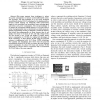Free Online Productivity Tools
i2Speak
i2Symbol
i2OCR
iTex2Img
iWeb2Print
iWeb2Shot
i2Type
iPdf2Split
iPdf2Merge
i2Bopomofo
i2Arabic
i2Style
i2Image
i2PDF
iLatex2Rtf
Sci2ools
ISCAS
2008
IEEE
2008
IEEE
A low-power monolithically stacked 3D-TCAM
—This paper presents three techniques to reduce the power consumption in ternary content-addressable memories (TCAMs). The first technique is to use newly developed monolithically stacked 3D-IC technology for the implementation, because vertical stacking can drastically reduce interconnect length in both matchlines and searchlines, hence reducing signal path delay and power consumption. The second technique is to replace the conventional SRAM memory in a TCAM with an array of programmable vias (or electrolyte non-volatile memory). Special programming circuitry is designed to read/write memory bits from/to the programmable via array because they do not simply store data in the form of low and high voltage levels. We also devised a new TCAM cell design to further reduce power consumption in TCAMs by taking full advantage of 3D-IC technology. A 1024×144-bit TCAM using the proposed
| Added | 31 May 2010 |
| Updated | 31 May 2010 |
| Type | Conference |
| Year | 2008 |
| Where | ISCAS |
| Authors | Mingjie Lin, Jianying Luo, Yaling Ma |
Comments (0)

